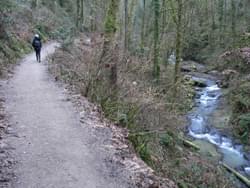




From "Connections," the newsletter of Massachusetts Department of Conservation and Recreation's Greenways and Trails Program (January 2008)
Designing sustainable contour trails that reduce maintenance needs while providing a good experience for visitors.
by Massachusetts Department of Conservation and Recreation

Designing and developing sustainable trails is the key to a successful trail system. The core elements of a sustainable trail are that it:
A trail that cannot balance these elements will not be sustainable, and should be closed or not developed.
While there are many factors that can influence the sustainability of trails, the key characteristics are that they:
A sustainable trail will lead users to desired destinations such as water features, historic sites, vistas, interesting landforms and user facilities; while avoiding wet areas, steep slopes, critical habitats, and other culturally or environmentally sensitive areas.
Erosion is the number one problem for sustainable trails. It damages trails, is expensive to repair and diminishes the user experiences. In New England, water is the primary erosive force. Trails that collect water or channel water will be both environmentally and economically unsustainable.
Trails lie on the land in three ways: along a fall-line (in the direction of the slope), on flat ground, or along the contour (perpendicular to the slope). Of these types of trails, only the contour trail on the side-slope easily sheds water and is thus sustainable.
When users leave the trail tread, they widen it, create braided trails, and create social trails. These can cause environmental damage and raise maintenance costs. Users leave the trail when it becomes eroded or wet, or when the trail does not meet their needs or expectations.
Sustainable trails and trail systems must meet different users' needs and expectations. If they do not, users may abandon the trails and / or create their own, less sustainable trails.
Ultimately, a sustainable trail design will most often be a trail that connects desired control points by roughly contouring along the sides of slopes.
So the contour trail is the most sustainable design, but how does one specifically lay out and create these trails so that they do not collect or channel water? A sustainable contour trail should conform to the following five "rules:"
1. Outslope: The trail tread should be outsloped (sloped away from the hillside) by 5%. This will allow water that comes on to the trail to flow off downhill and not be channeled down the trail.
2. Grade Reversals: While the trail will generally follow the contour of the land, it will also most likely either be climbing or descending slightly. However, a sustainable trail should also reverse its grade often (from down to up and vice versa, "surfing the hillside"). This will reduce the watershed of any given section of trail, prevent water from collecting and running down the trail, and reduce any erosion potential. Most trails should include grade reversals every 20 to 50 feet.
3. Half Rule: A trail's grade (percent slope) should not be any greater than half the grade of the hillside that it contours along. For example, if the slope of the hill the trail runs along is 16%, than the grade of the trail should be no more than 8%. This will allow water to flow across the trail, off the trail and continue down the slope. This is especially important along gentle slopes.
4. Ten Percent Average Grade: An average trail grade of 10% or less will be most sustainable, on most soils and for most users. This does not mean that shorter sections can't be steeper.
5. Maximum Sustainable Grade: The maximum sustainable grade is the steepest grade the trail will attain, and should be determined early in the planning process. Typical maximum grades may vary from 15% to 25%, but this is site specific and depends on factors such as soils, rainfall, the half rule, grade reversals, user type, desired difficulty level, and number of users.
Water bars are not sustainable. Use grade reversals or grade dips (small grade reversals) instead.
Use full bench (not partial bench) trail construction on side slopes.
Fully close and reclaim unsustainable trails. Brush piles at trail entrances don't work. You should block entrances, but also try to reclaim the entire corridor of closed trails.
Ice Age National Scenic Trail: Trail Stewardship Notebook
posted Mar 27, 2024
The Ice Age National Scenic Trail (NST) is a thousand-mile footpath highlighting Wisconsin’s renowned Ice Age heritage and scenic beauty. The Ice Age Trail Alliance (IATA) and its partners can shape users’ experiences. As stewards of the land and the Trail, we can help users develop a connection with the land and create a sense of wonder — even pique their curiosity enough to further explore the Trail.
Outdoor Enthusiasts Enjoy the Vermont Shorelines Thanks to the GEOWEB® Soil Confinement System
posted Mar 26, 2024
Outdoor enthusiasts enjoy scenic views along the Vermont shorelines thanks to the GEOWEB® Soil Confinement System.
posted Nov 25, 2023
This white paper provides collected best practices on winter bikeway maintenance as seen in US cities and around the world. The paper covers snow removal from bikeways, different types of de-icing surface applications and their advantages/disadvantages, and best practices for winter maintenance prioritization and scheduling. The paper also includes a brief discussion on innovative winter maintenance techniques either in use or in development.
Winter Maintenance Resource Guide
posted Nov 25, 2023
Who is responsible for winter maintenance—property owners or government agencies—and what are the challenges?
7,320 views • posted 01/19/2018